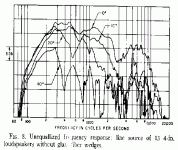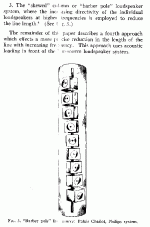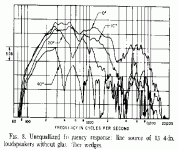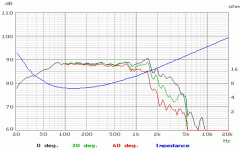If you mount two small full-range drivers like the Fostex FE103 virtically in a narrow baffle, will it sound worse than just one? Meaning if one sounds good, will two sound the same, just louder? Or can adding the second one screw up the imaging? If so, how can you tell what kind of spacing (like D'Appalito) there should be between the drivers so as to not screw up the imaging?
bbaker6212 said:If you mount two small full-range drivers like the Fostex FE103 virtically in a narrow baffle, will it sound worse than just one? Meaning if one sounds good, will two sound the same, just louder? Or can adding the second one screw up the imaging? If so, how can you tell what kind of spacing (like D'Appalito) there should be between the drivers so as to not screw up the imaging?
Hey baffle-man
The answer is, in theory, yes. At some frequency related to the distance between the 2 drivers the HF will start to add & cancel. An MTM XOs the 2 mid basses low enuff low enuff to avoid this. With 2 FE103s as close as possible this is in the 4-6k region.
dave
bbaker6212 said:Any way to remove or reduce this problem? Stagger the drivers with their centers not virtically alligned? Place them side-by-side?
Firing at different slightly different angles?
You can mount them co-axially (quite difficult in 3-space
dave
bbaker6212 said:Does the cancellations happen in close proximity to the drivers or farther out? Would putting something like neoprene rings on the baffle around the drivers help to reduce this bad effect?
No
dave
This thread has info and references you might find instructive:
http://www.diyaudio.com/forums/showthread.php?threadid=10115
http://www.diyaudio.com/forums/showthread.php?threadid=10115
2 full range etc
Dave,
I always thought that if you have two drivers close together and feed them with the same signal, you can consider them as one driver with a double area. If there is cancellation, why isn't there cancellation with a single driver from signals from different parts of the cone? Or is there, what they call beaming?
Jan Didden
Dave,
I always thought that if you have two drivers close together and feed them with the same signal, you can consider them as one driver with a double area. If there is cancellation, why isn't there cancellation with a single driver from signals from different parts of the cone? Or is there, what they call beaming?
Jan Didden
I always thought that if you have two drivers close together and feed them with the same signal, you can consider them as one driver with a double area. If there is cancellation, why isn't there cancellation with a single driver from signals from different parts of the cone? Or is there, what they call beaming?
Jan,
You could consider them one driver if you could manage to have both drivers exactly the same distance to your ears. However, this is practically impossible, since at higher frequencies, minute pathlength differences will cause cancellation. Slouching just a bit from the optimum seating position will destroy the tonal integrity at these higher frequencies. This is why one tweeter is almost always used, with the other drivers LowPassed.
Dave Hull
Re: 2 full range etc
There is cancellation resulting in beaming and roll-off. One of the reasons why a well designed phase plug can do so much good.
dave
janneman said:why isn't there cancellation with a single driver from signals from different parts of the cone? Or is there, what they call beaming?
There is cancellation resulting in beaming and roll-off. One of the reasons why a well designed phase plug can do so much good.
dave
Re: 2 full range etc
 ).
).
For the bass and much of the mids, you can. It is only in the upper frequencies that you run into these problems.janneman said:I always thought that if you have two drivers close together and feed them with the same signal, you can consider them as one driver with a double area.
I haven't done any research on this, but I would bet that if you could make two speakers with completely square diaphragms and surrounds, and placed them one atop the other, you probably would not have these problems. If you put two circles one atop the other though, you can see that the sound will tend to come from two sources. With square speakers, I would think the behavior would be very similar to a single diaphragm, (if they're square, I'm not sure you can call them "cones"janneman said:If there is cancellation, why isn't there cancellation with a single driver from signals from different parts of the cone? Or is there, what they call beaming?
Here is the frequency response of thirteen 4 inch speakers in a line source array. The authors eventually got smoother-but not flat response, from a combo of glass fiber wedges in front of the speakers. Flat response to 2,000 Hz was achieved with a simple equalizer circuit.
This is from an article, Constant Directional Characteristics From A Line Source Array by David Klepper and Douglas Steele, which was published in the Journal of The Audio Engineering Society in July, 1963.
Since it was a small graph, I had t fill in some blotchy parts around 500 Hz with MSPaint. But not much.
This is from an article, Constant Directional Characteristics From A Line Source Array by David Klepper and Douglas Steele, which was published in the Journal of The Audio Engineering Society in July, 1963.
Since it was a small graph, I had t fill in some blotchy parts around 500 Hz with MSPaint. But not much.
Attachments
Question:
Answer:
The question was about just two drivers, and the answer is correct.
However, for a line array, at least one company tried bbaker's approach. How successfully it worked out, I don't know. From the article above in the Journal of The Audio Engineering Society, here is all the info the article contains on this configuration.
Just thought I would throw this in for fun.
PS: This is a snippet from the article. The Barber Pole enclosure is not the authors' enclosure. They include it in the article just as a quick survey of work already done on Line Arrays. In case it is not clear, the Barber Pole enclosure does not contain any fiberglass wedges in front of the speakers. The authors' enclosure, which they go on to describe, has them. The Barber Pole does not.
bbaker6212 said:Any way to remove or reduce this problem? Stagger the drivers with their centers not virtically alligned? Place them side-by-side?
Firing at different slightly different angles?
Answer:
Planet 10 said:You can mount them co-axially (quite difficult in 3-space) or at an angle of at least 90 degrees (and if you are going that far you might as well do it 180 degrees and take advantage of push-push.
The question was about just two drivers, and the answer is correct.
However, for a line array, at least one company tried bbaker's approach. How successfully it worked out, I don't know. From the article above in the Journal of The Audio Engineering Society, here is all the info the article contains on this configuration.
Just thought I would throw this in for fun.
PS: This is a snippet from the article. The Barber Pole enclosure is not the authors' enclosure. They include it in the article just as a quick survey of work already done on Line Arrays. In case it is not clear, the Barber Pole enclosure does not contain any fiberglass wedges in front of the speakers. The authors' enclosure, which they go on to describe, has them. The Barber Pole does not.
Attachments
Re: Re: 2 full range etc
If you change square to rectangle, then consider that people are doing this with "ribbon" tweeters. You could also consider ESLs.
dave
kelticwizard said:I haven't done any research on this, but I would bet that if you could make two speakers with completely square diaphragms and surrounds, and placed them one atop the other, you probably would not have these problems. If you put two circles one atop the other though, you can see that the sound will tend to come from two sources. With square speakers, I would think the behavior would be very similar to a single diaphragm, (if they're square, I'm not sure you can call them "cones").
If you change square to rectangle, then consider that people are doing this with "ribbon" tweeters. You could also consider ESLs.
dave
Ribbons and electrostatics-didn't think of that. Yes, they are usually arrays too, now that you point it out.
That first chart in the thread-reposted below-shows the response for thirteen 4 inch speakers mounted in a vertical array. I noticed something surprising.
The off-axis response at 40 degrees off-axis is a shocking 17 dB below the on-axis response at 2,000 Hz! A single 4 inch speaker does much much better than that. With off-axis response like that, one of the best features that you would think an array gives you-horizontal off-axis response similar to a single driver of it's diameter but cone excursion much, much less-would appear to be imaginary. There are 10 inchers around which give better off-axis response than that!!
Does anybody have any idea why this would be?
That first chart in the thread-reposted below-shows the response for thirteen 4 inch speakers mounted in a vertical array. I noticed something surprising.
The off-axis response at 40 degrees off-axis is a shocking 17 dB below the on-axis response at 2,000 Hz! A single 4 inch speaker does much much better than that. With off-axis response like that, one of the best features that you would think an array gives you-horizontal off-axis response similar to a single driver of it's diameter but cone excursion much, much less-would appear to be imaginary. There are 10 inchers around which give better off-axis response than that!!
Does anybody have any idea why this would be?
Attachments
Here is the response graph, both on and off axis, for the 10" Peerless CSX 10" woofer, 850146. The cone area is 7 times as large as a 4" speakers, yet note the vastly superior off-axis response. Look at the 2,000 Hz line. At 60 degrees off axis, (red line), the Peerless 10" has significantly better response than the 4" line array does at only 40 degree off axis!
For the sake of Line Array fans, I can only hope that this is not the usual thing. If it is, why build a Line Array?
For the sake of Line Array fans, I can only hope that this is not the usual thing. If it is, why build a Line Array?
Attachments
kelticwizard said:For the sake of Line Array fans, I can only hope that this is not the usual thing. If it is, why build a Line Array?
Why not? You never know until you try, and for some of us, trying is what matters
(my case of drivers arrived today and construction starts tomorrow (today?))
kelticwizard said:That first chart in the thread-reposted below-shows the response for thirteen 4 inch speakers mounted in a vertical array.
What was the spacing on the 4"?
Peter, this paper you will probably find interesting.
Line-Source paper by P Taylor [888 kB]
dave
- Status
- This old topic is closed. If you want to reopen this topic, contact a moderator using the "Report Post" button.
- Home
- Loudspeakers
- Multi-Way
- is two full range drivers in one baffle a problem?



